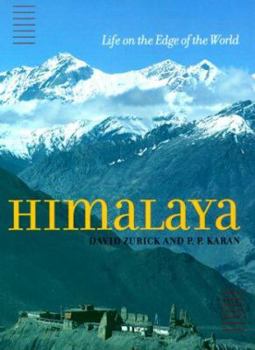Himalaya: Life on the Edge of the World
The majestic natural beauty of the Himalaya Mountains has inspired awe and religious devotion in people around the world for millennia. With thirty peaks rising over 25,000 feet (7,620 meters) --... This description may be from another edition of this product.
Format:Hardcover
Language:English
ISBN:0801861683
ISBN13:9780801861680
Release Date:November 1999
Publisher:Johns Hopkins University Press
Length:376 Pages
Weight:2.10 lbs.
Dimensions:1.4" x 7.3" x 9.8"
Customer Reviews
1 rating
Myths and Realities of the Himalayan Environment
Published by Thriftbooks.com User , 24 years ago
Zurick and Karan's book on the Himalaya is easily the best book in recent years focussing on the condition of the Himalayan environment. Instead of using evidence from a few small examples, usually villages scattered across the Himalaya from Pakistan to Assam, the authors invoke a meta analysis, an examination of many studies and especially data from the entire area. This technique avoids any instances of the universal fallacy, that is, generalizing from a few cases the characteristics of all. The thematic focus is on what is called The Theory of Himalayan Degradation as it was constructed by the alarmists in the 1970s into the 1980s including the German ecologist H-C Reiger, earth scientists Bruno Messerli and Jack Ives, and journalists like Erik Eckolm, a sometime science editor of the NY Times. Much of this concern, that there is a widespread environmental catastrophe in the Himalaya, is still being promoted. Zurick and Karan, both human geographers who have have been studying the Himalaya for a total of sixty years, find in their analysis that the Himalayan environmental situation is highly variable, problems exist, but the basic scenario that overpopulation causes cultivated land expansion and deforestation of steep lands, thereby increasing erosion, and silt laden runoff deposited downstream, is overly simplistic. The authors review a large number of field studies and data sets across the Himalaya and through cartographic analysis to demonstrate that the current status of the Himalayan environment is diverse. Through a series of seven intensive regional studies, in Himachal Pradesh, Uttarakhand, Nepal, Sikkim, and Bhutan the authors demonstrate the contemporary environmental status. Factors such as historical land tenure systems, trading routes, border closings, road building and migration all play critical roles in influencing environmental perturbation.For anyone interested in the Himalaya the book is well worth reading. The authors provide contextual photographs, copius notes to the chapters, and the very first published set of maps of Himalayan districts accompanied by tabular material on 100-year population, agricultural and forest data. The introductory chapters will provide the general reader with a good background to Himalayan habitat and society. I highly recommend it.Nigel J. R. Allan, author/editor, Human Impact on Mountains; Mountains at Risk: Current Issues in Environmental Studies; Karakorum Himalaya: A Bibliography.





